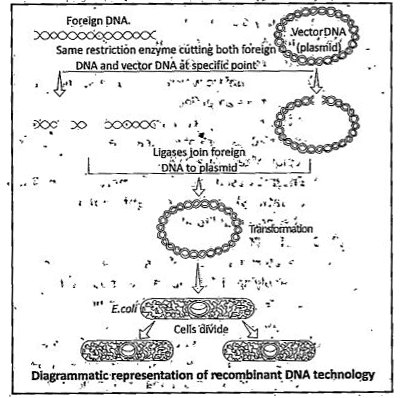Explain briefly the various processes of recombinant DNA technology. Solution in Telugu
Recombinant DNA technology involves several steps in specific sequence such as.
a) Isolation of DNA
b) Fragmentation of DNA by restriction endonucleases.
c) Isolation of a desired DNA fragment.
d) Ligation of the DNA fragment into a vector.
e) Transferring the recombinant DNA into the host .
f) Culturing the host cells in-a medium at large scale
g) Extraction of the desired product.
a) Isolation of DNA:
i) DNA is enclosed within the membranes. To release DNA along with other macromolecules such as RNA, proteins, polysaccharides and lipids, bacterial cells /plants.or animal tissue are treated with enzymes such as lysozyme (bacteria) cellulose (plant cells), chitinase (fungus) to digest cell wall.
ii) RNA can be removed by treatment with ribonuclease.
iii) Proteins can be removed by treatment with protease.
iv) Other molecules can be removed by appropriate treatments and purified DNA ultimately precipitates out. after the addition of chilled ethanol.
b) Fragmentation of DNA by restriction endonucleases : Cutting of DNA at specific locations can be done by using restriction enzymes. The purified DNA is incubated with the specific restriction enzymes at conditions optimum for the enzyme to act.
c) Isolation of a desired DNA fragment Is carried out using agarose gel electrophoresis-the DNA is negatively charged, it moves towards the positive electrode or anode and in the process, DNA separates out. The desired DNA fragment is eluted out.
Amplification of the gene of interest Using Polymerase Chain Reaction (PCR) is a reaction in which amplification of specific DNA sequences is carried out in vitro.
i) PCR technique requires :
a) A DNA template which is a double-stranded DNA that needs to be amplified.
b) Primers are small chemically made oligonucleotides of about 10-18 nucleotides that are complementary to a region of template DNA.
c) Enzymes, used are Taq polymerase (from Thermus aquaticus) and the vent polymerase (from Thermococcus litoralis).
ii) Steps in PCR :
a) Denaturation of double - stranded DNA is carried out by applying high temperature of for 15 seconds. Each separated single-stranded strand acts as a template for DNA synthesis.
b) Annaling is carried out in two sets of primers. Which are added and anneal to the 3. end of each separated strand. Primers act as initiator of replication.
c) Extension is done by DNA polymerase of primers by adding nucleotides complementary to the template provided in the reaction.
d) A thermostable DNA polymerase (taq polymerase) is used in the reaction which can tolerate the high temperature of the reaction.
e) These steps are repeated many times to obtain several, copies of desired DNA.
d) Ligation of the DNA fragment into a vector requires a vector DNA and source DNA.
i) These are cut with the same endonuclease to obtain sticky ends.
ii) Both are then ligated by mixing vector, DNA, gene of interest and, enzyme DNA ligase, to form recombinant DNA:

e) Insertion of recombinant DNA into the host cell Organism occurs. by several methods, before which the recipient cells are made competent to receive the DNA.
i) If recombinant DNA carrying antibiotic resistance (eg., ampicillin) is transferred into, E coli cells, the host cell is transformed into ampicillin resistant cells.
ii) The ampicillin resistant gene can be called as selectable marker.
iii) When transformed cells are. grown on agar plates containing : ampicillin, only transformants will grow and.other will die.
f) Culturing the host cells in a medium at a large scale: It. is carried out in appropriate medium at optimal conditions. The DNA gets multiplied and express itself to form desired products.
g) Extraction of desired, gene products : It is carried out by following steps.
i) A protein encoded gene expressed in a heterologous host is called recombinant protein.
ii) Cell is having genes of interest can be grown on a small scale or on a large scale.
iii) In small scale cells are grown on cultures and then expressed protein is extracted and purified by various separation methods.
iv) In large scale cells are grown in a continuous culture system in which fresh medium is added from one side to maintain cells growth phase and the desired. protein is collected from the other side:
Topper's Solved these Questions
Similar Questions
How does ascent of sap occur in tall trees ?
04:40View SolutionDescribe the structure of the heart of man with the help of neat labelled diagram.
05:44View SolutionGive an account of glycolysis, Where does it occur ? What are the end products? Trace the fate of these products in both aerobic, and anaerobic respiration.
45:52View SolutionExplain the process of recombinant DNA technology.
40:34View SolutionBriefly explaing the 'cutting' and 'ligation' of DNA during recombinant DNA technology or how is recombinant DNA produced ?
43:22View SolutionProcesses Of Recombinant Dna Technology
03:36View SolutionProcesses Of Recombinant Dna Technology
02:58View SolutionProcesses Of Recombinant Dna Technology
02:38View SolutionDefine recombinant DNA technology. Describe the various tools required for rDNA technology.
02:58View SolutionDescribe briefly recombinant DNA technology.
44:38View SolutionBriefly describe the various stages of recombination DNA technology of genetic engineering and its applications.
01:23View SolutionDescribe briefly recombinant DNA technology.
03:55View SolutionProcess of Recombinant DNA technology
09:17View SolutionVaccine of which STD is produced through recombinant DNA technology for its prevention?
06:11View SolutionExplain recombinant DNA technology.
View SolutionDescribe briefly recombinant DNA technology.
View Solution

